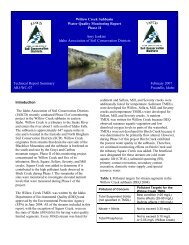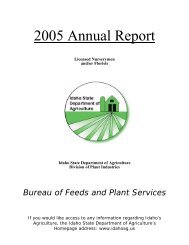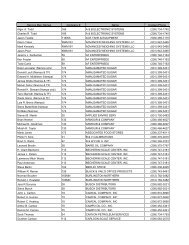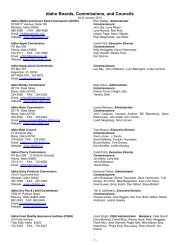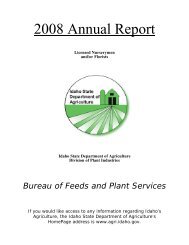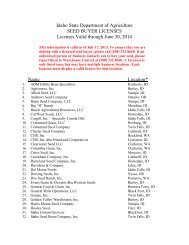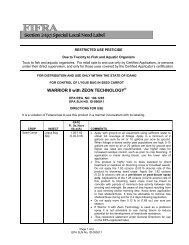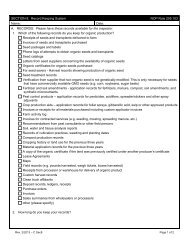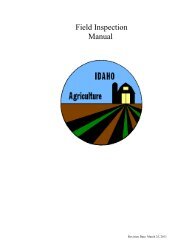2008 Statewide Strategic Plan for Eurasian Watermilfoil in Idaho
2008 Statewide Strategic Plan for Eurasian Watermilfoil in Idaho
2008 Statewide Strategic Plan for Eurasian Watermilfoil in Idaho
You also want an ePaper? Increase the reach of your titles
YUMPU automatically turns print PDFs into web optimized ePapers that Google loves.
Issue 7.0: Methods <strong>for</strong> survey of <strong>Eurasian</strong> watermilfoil<br />
The review panel heard concerns relative to the proper method to survey EWM <strong>in</strong>festations, as<br />
well who should have the authority and responsibility <strong>for</strong> pre- and post-treatment surveys of<br />
contracted aquatic plant treatment operations. This appears to be a concern due to perceived<br />
conflicts of <strong>in</strong>terest of commercial applicators survey<strong>in</strong>g and mapp<strong>in</strong>g pre- and post-treatment<br />
weed control ef<strong>for</strong>ts. Additionally, there was some confusion over the actual areas treated and <strong>in</strong><br />
some cases weed beds expanded between <strong>in</strong>itial surveys and application, as well as concern over<br />
treatments of areas that conta<strong>in</strong>ed native vegetation <strong>in</strong>stead of the targeted EWM.<br />
ISDA Response: The Aquatic <strong>Plan</strong>ts Program Manager and ISDA GIS staff will evaluate standard<br />
assessment techniques <strong>for</strong> mapp<strong>in</strong>g protocols <strong>for</strong> submersed aquatic vegetation and provide some<br />
guidance as to which methods are feasible <strong>in</strong> <strong>Idaho</strong>. The Program manager will also work to<br />
encourage participation <strong>in</strong> survey<strong>in</strong>g that is not tied to control contracts.<br />
Recommendation 7.1: Review survey techniques appropriate <strong>for</strong> the<br />
program goals.<br />
Be<strong>for</strong>e select<strong>in</strong>g a survey method, it is important to identify and describe the goals of a survey. If<br />
the purpose of a survey is to serve as a basis <strong>for</strong> control, then one needs to consider the type of<br />
control to be undertaken. Control of EWM or other <strong>in</strong>vasive plants might be categorized as<br />
eradication, high <strong>in</strong>tensity management or ma<strong>in</strong>tenance management (Smith et al. 1991).<br />
Eradication is control meant to completely elim<strong>in</strong>ate the non-native, <strong>in</strong>vasive plant from a water<br />
body and is rarely achieved. High <strong>in</strong>tensity management <strong>in</strong>volves the expenditure of large<br />
amounts of money and ef<strong>for</strong>t to reduce the abundance of the plant and slow its spread.<br />
Ma<strong>in</strong>tenance management is focused on reduc<strong>in</strong>g nuisances caused by the plant <strong>for</strong> recreational<br />
or other uses of a waterbody. In the case of a well-established and extensive population of EWM,<br />
ma<strong>in</strong>tenance management was considered by Smith et al. (1991) as the only realistic option <strong>for</strong><br />
management.<br />
In the cases of eradication and high <strong>in</strong>tensity management, one wants to know, to the extent<br />
possible, where all of the EWM plants <strong>in</strong> a lake are located so that they may be controlled. Ideally,<br />
this requires as complete a census of the plants <strong>in</strong> a water body as possible. Such a census<br />
would likely be per<strong>for</strong>med by SCUBA divers and require a high level of <strong>in</strong>vestment per unit area.<br />
In the case of ma<strong>in</strong>tenance management, it is important to know where EWM causes problems,<br />
such as <strong>in</strong>terference with fish<strong>in</strong>g, boat<strong>in</strong>g, swimm<strong>in</strong>g or water management. Problems such as<br />
these usually arise because the plant is abundant and grow<strong>in</strong>g near the water’s surface or matted<br />
at the surface. Areas with problems such as these can be readily identified and del<strong>in</strong>eated by<br />
people work<strong>in</strong>g either from boats (Newroth 1993) or, less commonly, from aircraft (Newroth 1993,<br />
Farone and McNabb 1993). After this is done, control may be planned and then carried out.<br />
If the purpose of survey were to evaluate the efficacy of control, <strong>in</strong> the cases of eradication and<br />
high <strong>in</strong>tensity management, one would expect to repeat the census done be<strong>for</strong>e control. In the<br />
case of ma<strong>in</strong>tenance management, one might consider a number of different approaches to<br />
evaluat<strong>in</strong>g abundance, <strong>in</strong>clud<strong>in</strong>g an assessment of the extent of matt<strong>in</strong>g at the water’s surface,<br />
biomass, distribution or some comb<strong>in</strong>ation thereof. Techniques <strong>for</strong> the assessment of biomass<br />
were described by Madsen (1993); these techniques <strong>in</strong>cluded the use of hydroacoustic systems,<br />
which also were described by Sabol et al. (2002). Assessment of the distribution, i.e., presence or<br />
absence, of EWM and other species may be done by l<strong>in</strong>e transect sampl<strong>in</strong>g (Titus 1993) or, as is<br />
more commonly done at present, po<strong>in</strong>t-<strong>in</strong>tercept surveys (Madsen 1999).<br />
67



